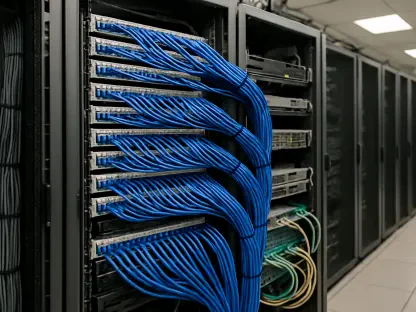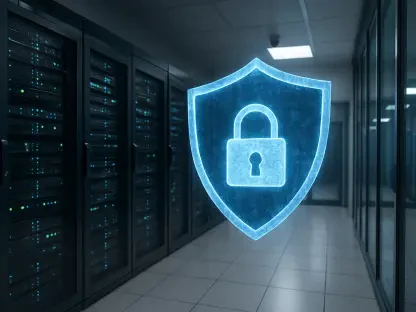The internet’s rapid evolution is reshaping the very fabric of society, with innovations like 5G networks and satellite connectivity extending digital access to even the most remote regions of the globe, fundamentally altering how people interact with technology daily. This transformation is not just about faster downloads or broader coverage; it’s about a significant shift in connectivity. However, as connectivity becomes more pervasive, a critical challenge emerges: balancing the benefits of this digital expansion with the urgent need to protect privacy and security. Every advancement, while promising enhanced access and efficiency, also introduces new vulnerabilities that can compromise personal data. This exploration seeks to uncover how current internet trends are influencing the delicate interplay between connectivity and safety. By delving into the latest technological developments, the associated risks, and potential safeguards, a clearer picture emerges of what it takes to navigate this hyper-connected era. The stakes are high, and understanding these dynamics is essential for anyone engaging with the digital world.
Exploring Transformative Internet Developments
High-Speed Connectivity Through 5G and Satellites
The advent of 5G technology marks a significant leap forward in telecommunications, delivering data speeds and reliability that redefine internet access across urban and rural landscapes alike. This next-generation network supports seamless streaming, real-time communication, and massive data transfers, fostering innovation in industries ranging from healthcare to entertainment. Its global deployment is set to enhance efficiency by connecting more users and devices with minimal latency. Yet, this widespread adoption also amplifies the challenge of securing such expansive networks. As 5G becomes the backbone of modern connectivity, the potential for sophisticated cyberattacks grows, demanding robust encryption and vigilant monitoring to prevent unauthorized access to sensitive information. The scale of this technology’s impact underscores the urgency of addressing these security concerns proactively.
Satellite internet, meanwhile, is proving to be a vital tool in closing the digital divide by bringing high-speed connectivity to areas where traditional broadband infrastructure is impractical or too costly to implement. This technology enables communities in remote regions to access educational resources, engage in global commerce, and stay connected with the world. Companies are launching constellations of satellites to provide consistent coverage, making internet access a reality for millions previously excluded. However, this expansion also raises critical questions about data protection over vast, decentralized networks. The risk of interception or misuse of data transmitted via satellite links cannot be ignored, as these systems often operate beyond the reach of conventional security protocols. Developing tailored safeguards for this unique connectivity method is essential to ensure that inclusivity does not come at the expense of privacy or safety.
The Expanding Web of IoT Devices
The Internet of Things (IoT) is driving an unprecedented wave of connectivity, linking everyday objects like household appliances, wearable tech, and industrial machinery into a sprawling digital ecosystem. This trend enhances convenience and productivity by enabling smart homes, automated factories, and real-time health monitoring, among other applications. As billions of devices come online, the demand for bandwidth and reliable networks surges, pushing the boundaries of what current infrastructure can handle. However, this hyper-connectivity also multiplies the entry points for potential cyber threats. Each connected device, if not properly secured, can serve as a gateway for hackers to infiltrate broader systems, exposing personal or corporate data. The sheer scale of IoT integration necessitates a reevaluation of how security is implemented across diverse platforms.
Beyond the immediate risks, the IoT explosion highlights a deeper challenge: ensuring consistent security standards across a fragmented landscape of manufacturers and protocols. Many IoT devices are designed with functionality in mind, often sidelining robust security features to keep costs low or speed up market entry. This oversight can lead to vulnerabilities like weak passwords or unpatched software, which cybercriminals exploit with alarming frequency. Addressing this issue requires collaboration between tech developers, regulators, and users to establish universal guidelines that prioritize data protection. As IoT continues to permeate daily life, from smart cities to personal gadgets, the focus must shift toward building resilient systems that can withstand evolving threats. Without such measures, the promise of a connected future risks being undermined by preventable breaches and loss of trust in digital solutions.
Addressing the Risks of a Connected World
Escalating Cybersecurity Concerns
As internet usage continues to soar, the frequency and sophistication of cybersecurity threats have reached unprecedented levels, posing significant challenges to individuals and organizations alike. Data breaches, ransomware attacks, and phishing schemes are becoming more common, often targeting personal information, financial records, or critical infrastructure. These incidents not only result in substantial monetary losses but also erode public confidence in digital platforms, making trust a scarce commodity in the online realm. The rise of remote work and digital transactions has further expanded the attack surface, as more sensitive data is shared across unsecured networks. Tackling these threats demands a multifaceted approach, combining advanced technology with greater user awareness to identify and mitigate risks before they escalate into full-blown crises.
Moreover, the evolving nature of cyber threats means that traditional defenses are often insufficient against new tactics employed by malicious actors. Hackers now leverage artificial intelligence to craft highly personalized attacks, bypassing conventional security measures with ease. This dynamic landscape underscores the importance of staying ahead of potential vulnerabilities through continuous updates to software, rigorous monitoring of network activity, and investment in cutting-edge threat detection tools. Governments and private entities must also collaborate to share intelligence on emerging dangers, ensuring a collective response to global cybersecurity challenges. Without such proactive efforts, the rapid growth of internet connectivity could become a double-edged sword, offering convenience at the cost of persistent exposure to digital harm.
Pressures on Digital Infrastructure
The relentless expansion of internet connectivity, fueled by trends like IoT and 5G, places enormous strain on existing digital infrastructure, revealing gaps in both capacity and security. Networks designed for smaller, less complex loads struggle to accommodate the surge in data traffic from billions of connected devices, leading to slowdowns and potential points of failure. These bottlenecks not only hinder performance but also create opportunities for exploitation, as overburdened systems are more susceptible to breaches or denial-of-service attacks. Upgrading infrastructure to handle this demand is a costly and time-intensive endeavor, yet it remains a critical priority to maintain the integrity and reliability of online services in an era of unprecedented digital reliance.
Compounding this issue is the uneven distribution of robust infrastructure across different regions, which exacerbates disparities in security preparedness. While urban centers may have access to state-of-the-art systems, rural or developing areas often rely on outdated technology, making them prime targets for cyberattacks. Bridging this gap requires strategic investments in scalable solutions that can adapt to future growth while embedding security at every level of design. International cooperation is also vital to establish standards that ensure consistency in how infrastructure is protected, regardless of geographic location. As connectivity continues to expand, addressing these structural weaknesses will be paramount to safeguarding the digital ecosystem against the mounting pressures of innovation and usage.
Building a Secure Digital Tomorrow
Leveraging VPNs for Enhanced Privacy
Virtual Private Networks (VPNs) have become indispensable tools in the quest to protect online privacy amidst the rapid expansion of internet trends. By encrypting internet traffic and routing it through secure servers, VPNs effectively mask user locations and shield data from prying eyes, whether from hackers or intrusive surveillance. This technology is particularly valuable in an age where public Wi-Fi and shared networks are commonplace, as it prevents unauthorized access to sensitive information during everyday online activities. However, the effectiveness of VPNs largely depends on the provider chosen, with reputable services offering strong encryption protocols and strict no-logs policies to ensure true anonymity. As digital connectivity deepens, adopting such tools represents a proactive step toward maintaining control over personal data in a landscape rife with potential threats.
Equally important is the recognition that VPNs are not a one-size-fits-all solution, and their role must be complemented by broader security practices to address the multifaceted risks of modern internet use. For instance, while VPNs excel at protecting data in transit, they do little to secure devices against malware or phishing attempts that exploit user behavior. Educating users on the limitations of these tools is crucial, as is encouraging the integration of VPNs with other defenses like antivirus software and secure browsing habits. Additionally, the market is flooded with options, and not all providers prioritize user safety over profit, sometimes compromising privacy through data logging or weak security features. Navigating this terrain requires diligence in researching and selecting services that align with stringent privacy standards, ensuring that the promise of protection is not undermined by hidden vulnerabilities.
Making Informed Choices in Security Tools
With an array of privacy and security tools flooding the market, discerning which options offer genuine protection is a critical task for anyone navigating today’s digital environment. Beyond VPNs, solutions like encrypted messaging apps, secure browsers, and multi-factor authentication systems play vital roles in fortifying online defenses against the backdrop of evolving internet trends. Evaluating these tools involves assessing factors such as encryption strength, ease of use, and the transparency of the provider’s data handling practices. A poorly chosen tool can create a false sense of security, leaving users exposed to risks they thought were mitigated. Staying informed about the latest advancements and potential pitfalls in security technology is essential to building a comprehensive shield against cyber threats that grow alongside connectivity.
Furthermore, the responsibility of securing a digital presence extends beyond selecting the right tools to adopting a mindset of continuous vigilance and adaptation. Cyber threats evolve rapidly, often outpacing the development of new protective measures, which means relying solely on static solutions is insufficient. Regular updates to software, routine checks for suspicious activity, and adherence to best practices like strong password creation are non-negotiable components of a robust security strategy. Collaboration between technology providers and end-users is also key, as feedback loops can drive improvements in tool design and functionality. As internet trends push the boundaries of what’s possible, embracing a proactive and educated approach to digital safety ensures that the benefits of connectivity are enjoyed without the constant shadow of compromise looming overhead.
Charting a Path Forward with Vigilance
Reflecting on the journey through internet trends, it becomes evident that the strides made in connectivity through 5G, satellite internet, and IoT have reshaped access on a global scale, yet they also expose significant vulnerabilities that demand urgent attention. The cybersecurity threats that emerge alongside these advancements test the resilience of digital systems, often revealing weaknesses that need immediate redress. VPNs and other privacy tools have proven their worth as critical defenses, though their success hinges on careful selection and integration with broader security measures. Looking ahead, the focus must shift to actionable steps: investing in scalable infrastructure, fostering international cooperation on security standards, and empowering users with knowledge to make informed choices. By prioritizing these efforts, the digital landscape can evolve into a space where innovation and safety coexist, ensuring that the promise of a connected world is fulfilled without sacrificing the fundamental right to privacy.









